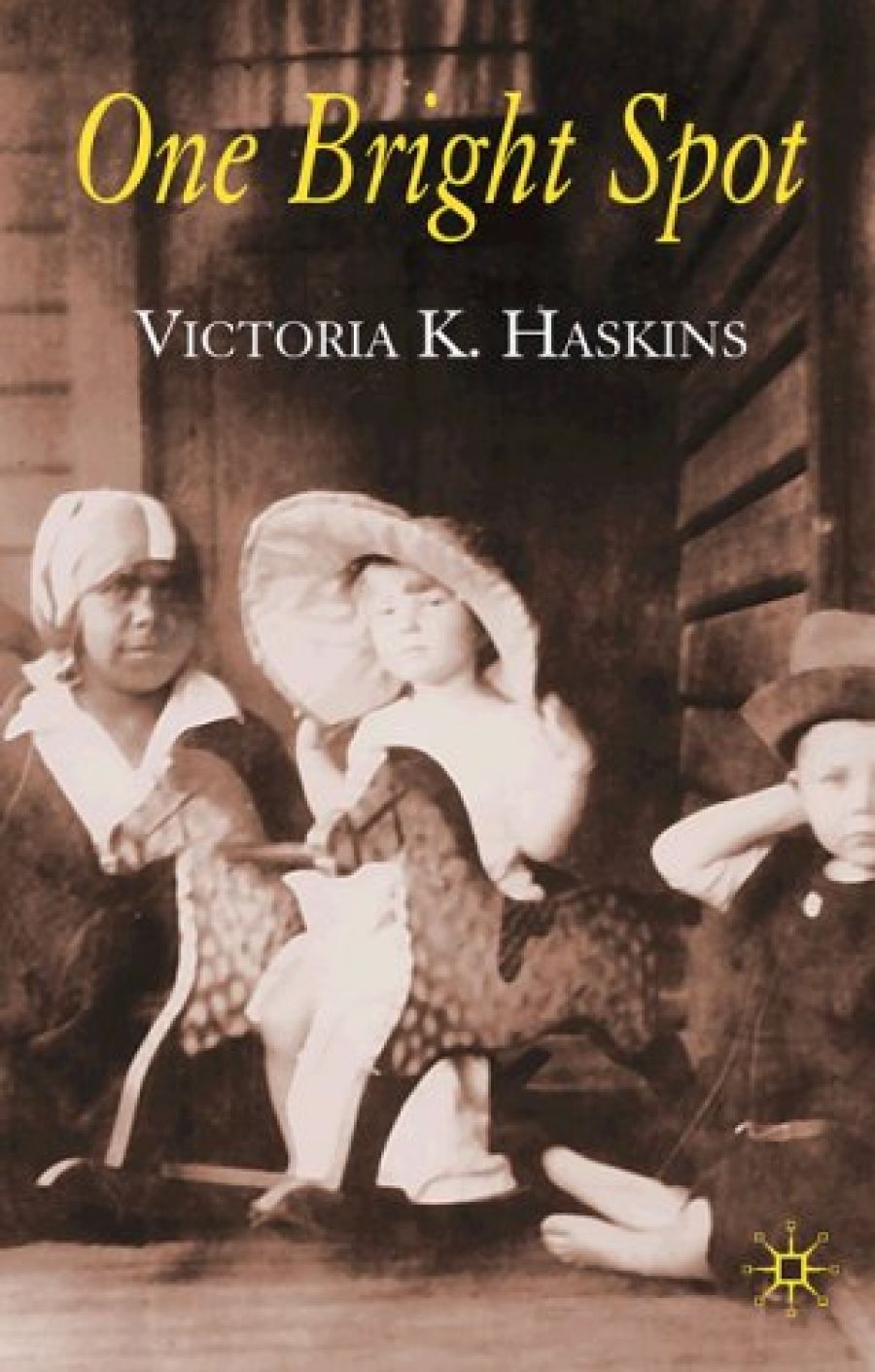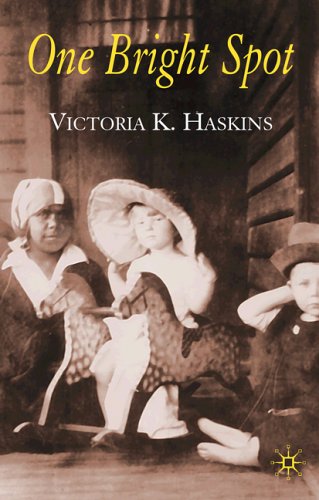
- Free Article: No
- Custom Article Title: A Racket
- Review Article: Yes
- Article Title: A Racket
- Online Only: No
- Custom Highlight Text:
In 1993, when Victoria Haskins undertook research into the relationship between Aboriginal and white women, she was ‘plunged into the argument that white academics were only perpetuating colonialism by writing Aboriginal people’s history … that white Australians should not, could not, try to speak for Aboriginal people, nor try to represent the Aboriginal experience’. Left floundering by ‘the difficult politics of writing Aboriginal history as a white Australian scholar’, Haskins was unreceptive to her grandmother’s pleas to embark on the despised ‘trivial bourgeois pursuit’ of family history, dismissed as ‘middle-class … the province of mildly ridiculous ageing relatives, searching for the dates of their ancestors’ arrival in the colonies’. But curiosity about an old photograph of her grandmother as a fair-haired toddler with an Aboriginal nanny prompted her to root out her great-grandmother’s boxed papers, then languishing in an aunt’s garage.
- Book 1 Title: One Bright Spot
- Book 1 Biblio: Palgrave Macmillan, $35 pb, 281 pp
- Book 1 Cover Small (400 x 600):

- Book 1 Cover (800 x 1200):

Haskins discovered that between 1938 and 1940 Joan Kingsley-Strack, known as ‘Ming’, was the secretary of the interracial Committee for Aboriginal Citizenship, founded in the 1930s by Aboriginal activists Bill Ferguson and Pearl Gibbs. Haskins had struck gold. Ming’s voluminous records mapped her political and personal journey from the early 1920s to the mid-1940s, starting with her association with the ultra-right New Guard, a NSW political organisation that at one time appeared poised to overthrow the elected government; taking in a couple of feminist groups; and culminating in strident advocacy for Aboriginal rights. Haskins’s indisputable ownership of this story, dovetailing with her research interests, also pre-empted turf wars with indigenous scholars.
The photograph that fired Haskins’s interest was the key to Ming’s progressive radicalisation. Ming’s successive young Aboriginal maids were representatives of the ‘stolen generations’, whose fate was seared into recent public consciousness by the Bringing Them Home report (1997). They were, as Ming realised in the 1920s, the victims of the interwar government policy of the forcible removal of Aboriginal children from their families. They were locked up in remote and frequently abusive institutions until they could be ‘apprenticed’ as servants, thereby providing a pool of cheap labour for white middle-class Australians.
This system of indentured labour was so appalling that even a few of the employers who profited by it were outraged. Ming’s activism was initially inspired by the discovery that a previous employer’s son had with impunity repeatedly molested and raped one of her maids. Instead of acting upon such complaints, authorities routinely ignored or covered up sexual abuse, or punished the victims by banishing them to native reserves if they became pregnant.
Another affront to the conscience and self-image of a few employers like Ming was the mandatory payment of servants’ wages into trust funds controlled by the hated and misnamed Aborigines Protection Board (APB). Ming eventually refused to comply with a practice that transformed employers into de facto ‘slave owners’. The Board deprived Aboriginal workers of the most basic autonomy, artificially depressing wage rates, and indefinitely withholding pay, without any accountability. In the press, Ming furiously denounced the Board as a ‘racket’ and ‘a great poisonous fungus’.
Ming’s personal crusade, pursued initially on behalf of her own maids, ended in defeat and humiliation. Any aspirations for a better life entertained by her maids were crushed. Owing in part to Ming’s increasingly tense relations with the Board, three were returned to native reserves, where one later died, aged thirty-seven, of pneumonia and probable malnutrition, leaving behind six children. The last maid was charged with breaking a doctor’s window in the context of a long-running dispute with him. Before sentencing, she was declared insane on the flimsiest of pretexts and held in an asylum for more than twenty years. Stranger than fiction, her tragedy may have broken Ming, who thereafter abandoned her political activities.
Haskins critiques Ming’s ‘maternalistic’ Christian philanthropic discourse about the welfare of young Aboriginal women. She was optimistic that exposure of flagrant abuses would lead to reform, but her ‘maternalism’ was no match for the inertia and entrenched self-interest of the APB and its backers. Despite her political and establishment connections, the odds were always against Ming.
Haskins is circumspect in giving Ming credit for her assault on the untrammelled powers of the APB. She is quick to disown the ‘ubiquitous colonial mythology of kindly white mistresses – the so-called “good-fella missus legend”’, highlighting instead ‘the hard realities of the gross disparities of power between women, militating against mutual affection, let alone friendship’. When she proclaims that she is ‘concerned not to romanticise Ming’s life and actions, not to pursue a redemptive narrative of the beloved “little missus”, not to reinscribe white dominance over Aboriginal women’, Haskins appears to be addressing ‘the collective of Aboriginal women historians who admonished white feminists in the early 1990s: just because you are women doesn’t mean you are necessarily innocent. You were, and still are, part of that colonising force.’ To my ears, Haskins’s anxiety to prove that she is observing the correct protocols for writing Aboriginal history (‘their stories are not mine to tell’) results in a jarring overcorrection of colonial discourses. Consequently, the tone of this work can be unstable, ranging from hectoring to defensiveness, as Haskins frames Ming’s responses, foregrounding with the superiority of youthful hindsight, the complacency, and narrow class and personal self-interest and even emotional neediness that motivated and finally limited Ming’s battles.
Haskins’s own explanation for reformers like Ming is dialectical. The recoil of some employers from government policies of exploitation and oppression that directly benefited them was the product of the system’s internal ‘contradictions’: ‘white mistresses, being positioned between the state and the Aboriginal women were intermediaries involved in an intimate, day to day experience of the practice of the state’s Aboriginal policy … (and their direct experience of) the reality of exploitation and abuse’ created ‘the potential for some kind of alliance between women … even in such a rigidly divided hierarchy of race and class’.
While diminishing the agency of the protesters, this argument does give Haskins the opportunity to demonstrate that the history of whites and Aborigines is intertwined. But her dialectical model makes little of her observations that, in her advocacy of Aboriginal rights, Ming sometimes enlisted the support of her husband, Norman Kingsley-Strack, and his associates in the reactionary paramilitary organisation, the New Guard. All the more remarkable, given their unhappy marriage and eventual divorce. Indeed, Ming’s diaries suggest that it was during their political activism that they seemed most united and mutually supportive. Unintentionally perhaps, Haskins’s narrative also supports the old sociological truism that reformers tend to be the very bourgeois from whom academics prefer to distance themselves.
In One Bright Spot, Haskins charts the evolution of her own great-grandmother from genteel feminist to political campaigner for Aboriginal rights. Joan Kingsley-Strack’s voluminous papers, including diaries, correspondence and other records, are a precious resource, vividly documenting contemporary responses to the stolen generation.
One Bright Spot also exerts the page-turning spell of a literary-historical detective work. In reconstructing Ming’s relationship to successive Aboriginal maids, Haskins attempts to determine the extent and the limits of the collaboration of white Australians with government policies towards Aborigines from the 1920s to the 1940s, with some refer-ence to earlier periods. Her biographical emphasis is one of the most accessible and compelling ways of engaging general readers in historical issues. Without too much fictionalisation, Haskins has found enough in the primary sources to tease us with the closeness of her subjects, to the extent that our yearnings for resolution are frustrated by the inevitable blanks. For those like myself who come to the subject without much prior knowledge, she provides a wealth of basic reference points. She also contributes a more psychological and speculative dimension, particularly with regard to the shaping of identity and values. While enjoying the sophistication of her analysis, I sometimes found her views challenging, or provocative, as was no doubt intended.


Comments powered by CComment